A Google search beginning with the word “pizza” will often prompt the search engine to autofill the rest: “pizza near me.” This shouldn’t be a surprise. It only indicates how popular the search term “pizza near me” is.
Unfortunately for pizzeria operators, merely existing in the vicinity of somebody searching “pizza near me” does not necessarily lead to their pizzeria showing up near the top of those search results—if the pizzeria shows up at all. In the modern age, mastering “local SEO,” as it is referred to, is critical to capturing sales. So how can operators ensure their business is well positioned to attract Google search traffic?
Here’s a look at some key things to remember when you’re trying to best position your pizzeria in Google’s all-important algorithm via search-engine optimization (SEO).
Related: How to Create The Pizza Crust Of Your Dreams
Enhancing Your Pizzeria’s ‘Google My Business’ Profile
A pizzeria’s presence on Google hinges on its “Google My Business” page. Making sure all information on the page is correct is a critical first step.
Creating or editing a Google My Business page can be done here. Operators should make sure hours of operation are correct prior to fine-tuning some other areas of their profile.
One of the keys to attracting eyeballs on Google is the brief company description. Here’s a highlighted example:

In order to perfect the company description, operators should first brainstorm a list of things that separate their pizzeria from the competition. Maybe the pizzeria has a great outdoor patio area or a killer tomato sauce that everyone raves about. Those key attributes must find their way into the pizzeria’s description. This will help attract more specific searches, like, for example, “pizzeria near me, great outdoor seating area.”
The business description is also a great area to lean into geographical keywords. This would mean including things like “uptown” or “east side” in the description. Similarly, if the pizzeria specializes in a unique style of pie, this would be the place to highlight that. Things like “wood-fired pizza” or “brick-oven pizza” can also help attract those looking for a specific experience.
Create Cohesion Across Platforms
The more digital cohesion a pizzeria is able to create across platforms, the better. In other words, a pizzeria’s name, address, phone number and website should all be readily displayed not just on Google My Business, but on social media platforms like Instagram and Facebook, as well as websites like Yelp and Yellow Pages.
This will not only give customers a clear way to find or contact your pizzeria, but will also give Google’s algorithm a strong sense of your pizzeria’s location and footprint.
Optimizing Your Pizzeria’s Website For SEO Traffic
A pizzeria’s website is another area that can influence Google “stickiness.” In order to increase SEO traffic, operators may consider writing out a longer business description in an “about” section of the website. This is a good area to focus on more specific searches that may connect a user to your site. Again, this is where keywords can come into play—and in this case, pizzerias have the added advantage of being able to work in as many as possible. This may be a good opportunity to lean into features like being “independently owned and operated,” or being ranked on a “best of”-style list.
Pizza brands might also consider launching a blog with thought-leadership articles with titles that a person might type into their search bar. For example, “Looking For Perfect [Insert Style] Pizza?” could be a way to reinforce a pizzeria as a go-to spot for that style of pie.
One thing to keep in mind with a blog is that it’s a commitment. An out-of-date blog can be worse than having no blog at all. A pizzeria should establish a plan for how to keep its blog fresh before launching one. It’s very possible a blog isn’t right for every pizzeria.

unapizza.com
Keep Up With Review Sites
Yelp and Google Reviews can be the bane of an operator’s existence. It may sometimes feel unfair that anybody can sit behind a keyboard and take a torch to a small business’s reputation for the slightest of grievances.
However, even if the average consumer can see through an overly aggressive review, they still may pay attention to a pizzeria’s overall rating on Google, Yelp or other review sites. If they’re choosing between two local pizzerias and one has a 4.6 rating and the other a 4.1 rating, that alone will often make their decision as to where they dine—it’s not a given they’ll even read the actual reviews themselves.
Following up on both positive and negative reviews can show that an operator cares. They can also potentially rectify a negative review—sometimes a simple “we understand your complaint, and we’re sorry that you had that experience” message can be enough to get a reviewer to give a restaurant another chance or even change their review.
It can also be beneficial for a pizzeria to nudge its customers toward creating a review. This can be as simple as leaving signage at the registers or on tabletops, or having servers encourage diners at the end of their meal to consider leaving a review.
“If that doesn’t work,” writes SEO expert Michael Ramirez, “Simple incentives (e.g., ‘review us on Google and get 20% off’) are a great motivator.”
Remember, SEO is Your Friend
While all of this may sound like a lot, it’s worth remembering that everything listed above is free. The digital age has given pizzerias the unprecedented opportunity to advertise their business to anyone with a smartphone or computer for nothing but a little sweat equity.
Having a consistent digital presence can lead to more sales. And isn’t that every pizzeria’s goal?













